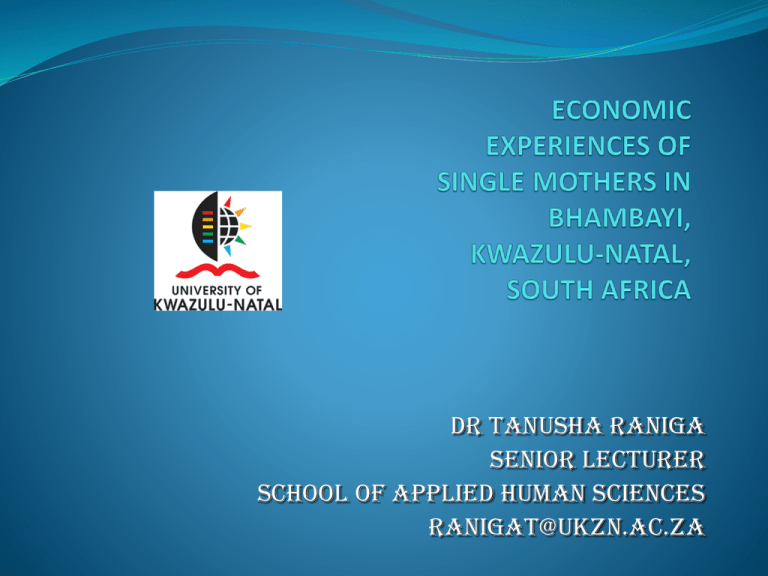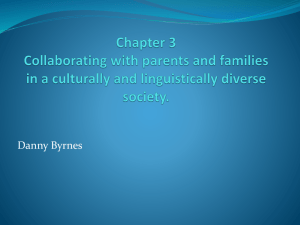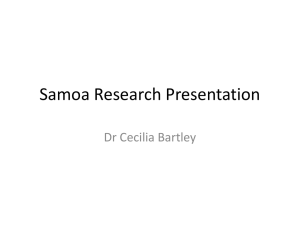economic experiences of single mothers in bhambayi
advertisement

Dr Tanusha Raniga Senior Lecturer School of Applied Human Sciences ranigat@ukzn.ac.za Principles of Kwanzaa Kwanzaa is centred on seven principles – called Nguzo Saba in Swahili. They are: UMOJA (Unity): Stresses the importance of togetherness for the family and community, which is reflected in the saying: “I am because We are”. Kujichagulia (Self-determination): requires that we define our common interests and make decisions that are in the best interests of the family and community. Ujima (collective work and responsibility): reminds us of our responsibility to the past, present and future and that we have a role to play in the community, society and the world. Kwanzaa Principles Ujamaa: (Co-operative economics): emphasises our collective economic strength and encourages us to meet common needs through mutual support. Nia (Purpose): encourages us to look within ourselves and to set personal goals that are beneficial to the community. Kuumba (Creativity): encourages us to make use of our creative energies to build and maintain a strong and vibrant community. Imani (Faith): focuses on honouring the best of our traditions, draws upon the best in ourselves, and helps us strive for a higher level of life in humankind, by affirming our self-worth and confidence in our ability to succeed and triumph in righteous struggle Women, Poverty & Economic Relations The growing number of women and children who are poor and live within female-headed households defines the ‘feminisation of poverty’ Poverty is quantitatively and qualitatively different for women as a result of the systematic discrimination that they face in education, health care, food security, access to microcredit, land and employment in the first economy. Although women make up 50% of the global population, they comprise 70% of the world’s poor % 66% of the illiterate population. Women and economic relations Neoliberal globalisation has perpetuated the feminisation of poverty in developing nations as they continue to bear the brunt of structural discrimination inherent in structural adjustment programmes. With the global economic downtturn since 2008, in sub-Saharan Africa 8 out of 10 women employed in the first economy have either lost their jobs or been put on contract positions. The Context for this study Women living in poverty often initiate livelihood activities as a means to support themselves and their families. Frye and Kirsten (2012) argue that as a result of the skewed distribution of resources and income, millions of women who embark on small-scale livelihood activities rarely earn enough income to lift themselves and their families out of poverty. Even though these small-scale livelihood activities supplement the household income, they are insufficient to lift single mothers out of poverty South African Context South Africa’s economic and policy transformation has placed much emphasis on the promotion of livelihood activities in lowincome communities (White Paper on Social Welfare 1997; National Department of Social Development Strategic Plan, 2010-2015). Such self-generating strategies corroborates the developmental approach to welfare, which emphasises social and economic development as two interdependent and mutually reinforcing processes (Patel, 2005; Patel, 2008). In fact Lombard (2008) and Patel (2008) propose that the implementation of income-generating activities is one of the poverty-alleviation strategies that would enhance the transformation and economic development agenda in the country. Research Context This study was conducted in a predominantly informal settlement named Bhambayi in Inanda, KwaZulu-Natal, where 25 single mothers engaged in individual livelihood activities that included agricultural production, beadmaking, catering, hairdressing, gardening and sewing. Situated in one of the most impoverished regions in KwaZulu-Natal, Bhambayi faces high rates of unemployment, inequality and HIV and AIDS, especially among female-headed households. Consequently most households are dependent on state social grants and often tenuous income strategies. The Population Pyramid of Bhambayi based on Quantitative Survey conducted in 2007 80 - 84 70 - 74 60 - 64 50 - 54 % Female 40 - 44 % Male 30 - 34 20 - 24 10 - 14 0-4 -8 -6 -4 -2 0 2 4 6 8 CONTEXT OF STUDY Results showed: 67% of the economically active population were unemployed (Raniga and Simpson 2011) The adult to child dependency ratio was 1:07 QUANTITATIVE AUDIT 40% of the household heads reported having lost at least one person through AIDS in the past twelve months at the time of the study in 2007 Female-headed households average an annual income of R30 000 Objectives of the study Obtain baseline information to construct the biographical profiles of 25 single mothers in Bhambayi; Gain insight into their economic experiences while involved in an livelihood activity; Explore suggestions for transformative action. Selection of participants Brown’s (2007:128) assertion that “feminist unpacking of women’s narratives places the problem stories outside of the women themselves”. Thus rather than focusing on their life experiences linked to the pathology of the poverty deprivation trap (Swanepoel & De Beer, 2006), the women were encouraged to relate their experiences of implementing their livelihood activities, thereby raising consciousness about the gaps, uncertainties and contradictions of patriarchal institutions in society. Continued Selection followed a purposive process where 25 single women were selected through snowball sampling. The secretary of the BRDF referred five women whom she knew and who fitted the following characteristics for selection : Lived in Bhambayi for more than five years; Were self-employed; Involved in a livelihood activity for at least one year; Was the head of the household; Was single with children. The initial five women were interviewed and they were invited to identify other single mothers based on the characteristics for selection. Data collection process Four semi-structured in-depth interviews were held with 25 single mothers It provided the forum to engage the women in understanding their biographical profiles and experiences within the broader socio-economic and gendered framework. Each narrative collected during the in-depth interviews provided insight into how living in an impoverished community with high levels of unemployment, disease and poverty had had a profound impact on their experiences of implementing their livelihood activity. Continued The topics covered in the four interviews were: understanding their life circumstances, previous training and work experiences, economic challenges, balancing domestic responsibilities, and suggestions for enhancing the sustainability of their livelihood activity. Since this study presents the findings from a small sample of 25 women, the findings cannot be generalised. However prolonged engagement and the rich descriptive details shared by the participants about their economic experiences served to enhance the trustworthiness of the findings (Terre Blanche, Durrheim & Painter, 2006). BIOGRAPHICAL PROFILE Sixteen of the women were aged 15-19, while six were 20-29; two were 30-35, and one was 40 years of age (N=25). The mean age was 20. Participants reported that they were heads of their households and it was not surprising that the average dependency ratio was 7. In South Africa as a whole 41.9% of households are female-headed (Census 2011). All of the single mothers were in receipt of the child support grant of R 210 ( 20USD) (Social Assistance Act, 2004) at the time of study. The average level of education was Grade 7 and evidently only three (12%) single mothers had completed secondary school. Continued All of the women rationalised the need to supplement their menial income received from the state child support grant by engaging in a livelihood activity such as sewing, knitting, bead-making, cooking and baking, gardening, hairdressing and vending. These single mothers were doubly disadvantaged, as they were expected to put food on the table while retaining the overwhelming burden of child care and household responsibilities (Raniga & Mathe, 2011). Institutional barriers leading to economic insecurity Mihindou (2006:34) argues that despite the African woman’s increasing participation in the labour market, existing gender inequalities have intensified with respect to working conditions and compensation. One woman commented that “living in an impoverished community means that daily our lives are filled with insecurity”. Another woman who sold fruit and vegetables stated: “I don’t make enough money because people tend to go to the Dube Mall to buy their food”. Participant 19, who was also a vendor, commented: “the money I make selling door to door is not enough to feed 7 people at home. My business does help me but it is not enough to get out of poverty”. Obstacles experienced A major barrier experienced by all the women was the non- access to micro-credit loans from private sector banks and multinational companies. Some of the comments of the women were: “The male who interviewed me at the bank was rude and unhelpful”. “He made me feel like I was stupid because I could not speak English”. “I was unable to fill in the forms in English so I just left”. “I have to deal with a lot of problems and stress because I am not confident to approach the bank for a loan”. “There are lots of forms which I don’t understand and this makes it difficult to get loans from to grow my business”. Results In many transitional economies poor women have relatively low access to micro-credit schemes and other economic resources (Osman, 2002). The comments made by the women who were heads of their households reveal the extreme constraints experienced in their attempts to access credit, capital and/or services from private banks (Heintz & Jardine, 2008). Clearly the implication of low literacy levels was that the women were not confident to negotiate with mainly male personnel at the banks that they had approached in their endeavour to access micro-credit to expand their businesses. Continued The women also talked about the unskilled and physically demanding nature of their work, with low productivity and little opportunity for acquiring further training and improving their skills with the goal of sustaining their activities. One woman proposed that they “engage government in establishing poverty-focused development banks as a means of accessing micro credit”. Another woman suggested “getting involved in literacy classes, and business training courses”. These could be funded by the poverty-focused development bank. Lack of support from local government The majority of the women perceived this to be the function of the ward councillor, who they felt was elected to represent their needs at the eThekwini Municipality. The women suggested the following: “The eThekwini Municipality needs to provide space in the markets within the Inanda region and outside so that they can sell some of their products”. “Most of the people go to the big supermarkets to buy their fruit and vegetables because they are cheaper”. What was mentioned by the participants was that multinational companies in the Inanda region tended to monopolise the market and that this limited opportunities for single mothers involved in livelihood activities to become economically selfsufficient. The strengths and limitations of social networks Obtaining a balance between domestic responsibilities and implementing the livelihood activity was a frequent concern mentioned by the participants. Nnaemeka (1995) aptly argues that socio-cultural constraints such as the nurturing and caring role played by women in Africa restricts them from developing their potential and realising personal aspirations. Continued One single mother commented: “our involvement in livelihood strategies tends to be perceived as an extension of our household duties”. Participants 4, 8, 11 and 15 stated that: “if only we could get support to take care of the children at home, we would be more productive and work longer hours. Now we rush home at 2 pm to see to children after school”. These women’s comments reflect the difficulties that women who are self-employed in the second economy face in balancing their household responsibilities. Furthermore, they felt that the economic activities that they engaged in remain unvalued and uncompensated as they do not form part of the formal first economy. Continued 12 of the single mothers in this sample spoke about the ability of household family members to pool their strengths, identify opportunities to engage in economic activities and build social networks, which often signalled the difference between further impoverishment and greater stability. These women acknowledged the immense support and care that older women (grandmothers, older siblings, aunts) who were living with them in the household played in respect of taking care of children. These women were able to work flexi-hours without the stress of domestic responsibilities. They also mentioned that they were able to reap the economic benefit of this support. One woman stated: “I am able to sew more items and market my items without the worry of rushing home to care for children. My aunt who has lived with me for five years is my biggest support”. These informal safety networks were perceived as enhancing the bonding social capital in the community and these social networks provided much needed support in times of economic and social distress precipitated by poverty (Raniga & Simpson 2010). CONCLUSIONS A highlight of this study was that single mothers showed a remarkable sense of motivation in wanting to succeed and break out of poverty. Most encouraging was the positive outlook of those with strong informal safety networks, who in spite of high levels of vulnerability and economic hardship displayed a strong desire to succeed in life. Of concern is the finding that none of the single mothers felt confident enough to negotiate access to micro-credit from mainly male personnel employed at private sector banks and multinational companies. RECOMMENDATIONS Transformative interventions should include the establishment of a business forum to assist single mothers to network and lobby for funding and to implement business training programmes; It is important that policy makers relate livelihood activities of single mothers to the economic objectives of social development through access to micro-credit schemes, better access to literacy and training programmes, and greater gender equality. National policy and regulatory changes which expand micro-credit choices for poor women by private and public donors as well as child care subsidies are necessary in order to assist single mothers to gain more control over their social, political and economic lives; RECOMMENDATIONS Lobbying by social workers and other advocacy groups to ensure visibility and accountability by ward councillors and for them to adequately address the economic and educational needs of single mothers in informal settlements is necessary; This study represented a limited sample of 25 African single mothers from an impoverished community and does not represent other population groups in contemporary South Africa. This clearly warrants further qualitative research being conducted with a mixed-race profile to explore the economic experiences of single mothers across different provinces in South Africa. Final words NGIYABONGA ASANTE






